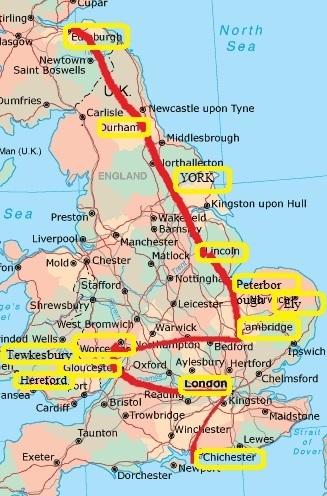U.K. 2013 
Day 16, Tuesday
September 18, 2013
Hereford
We got up early again because we had a 9:15 train to Hereford. We did
order some eggs and bacon from the menu in addition to the cereals and
pastries for breakfast. Back to the train station. It was about a 40
minutes ride south. We could see the Malvern Hills off in the distance,
the landscape was beautiful. We went through three tunnels.
 The train station was too far from the cathedral to walk, so took a
taxi. We went to the gift shop for our 11:00 tour. There was another
man who wanted to go on a tour, so we invited him to join us. Well, no
one showed up to give the tour and no one knew what happened to that
person. The cathedral staff were very embarrassed. After a bit, the
Chancellor, the Rev. Canon Chris Pullin, found us and spent some time
with us. They had called one of their guides, who was at the time
working in her garden. In about 15 minutes she showed up and gave us a
wonderful tour for about 2 ˝ hours.
The train station was too far from the cathedral to walk, so took a
taxi. We went to the gift shop for our 11:00 tour. There was another
man who wanted to go on a tour, so we invited him to join us. Well, no
one showed up to give the tour and no one knew what happened to that
person. The cathedral staff were very embarrassed. After a bit, the
Chancellor, the Rev. Canon Chris Pullin, found us and spent some time
with us. They had called one of their guides, who was at the time
working in her garden. In about 15 minutes she showed up and gave us a
wonderful tour for about 2 ˝ hours.
The early history of Hereford Cathedral is linked with the life and
death of their patron saint, King Ethelbert. The Anglo – Saxon Chronicle
contains this entry: “Offa, King of Mercians, commanded the head of King
Ethelbert to be struck off.” Later narratives from the 14th century
reported that Ethelbert was a young man (about 14 years old) who was
born in East Anglia in the late eighth century. He journeyed to Mercia
to seek the hand of Aelfrytha, the daughter of King Offa. For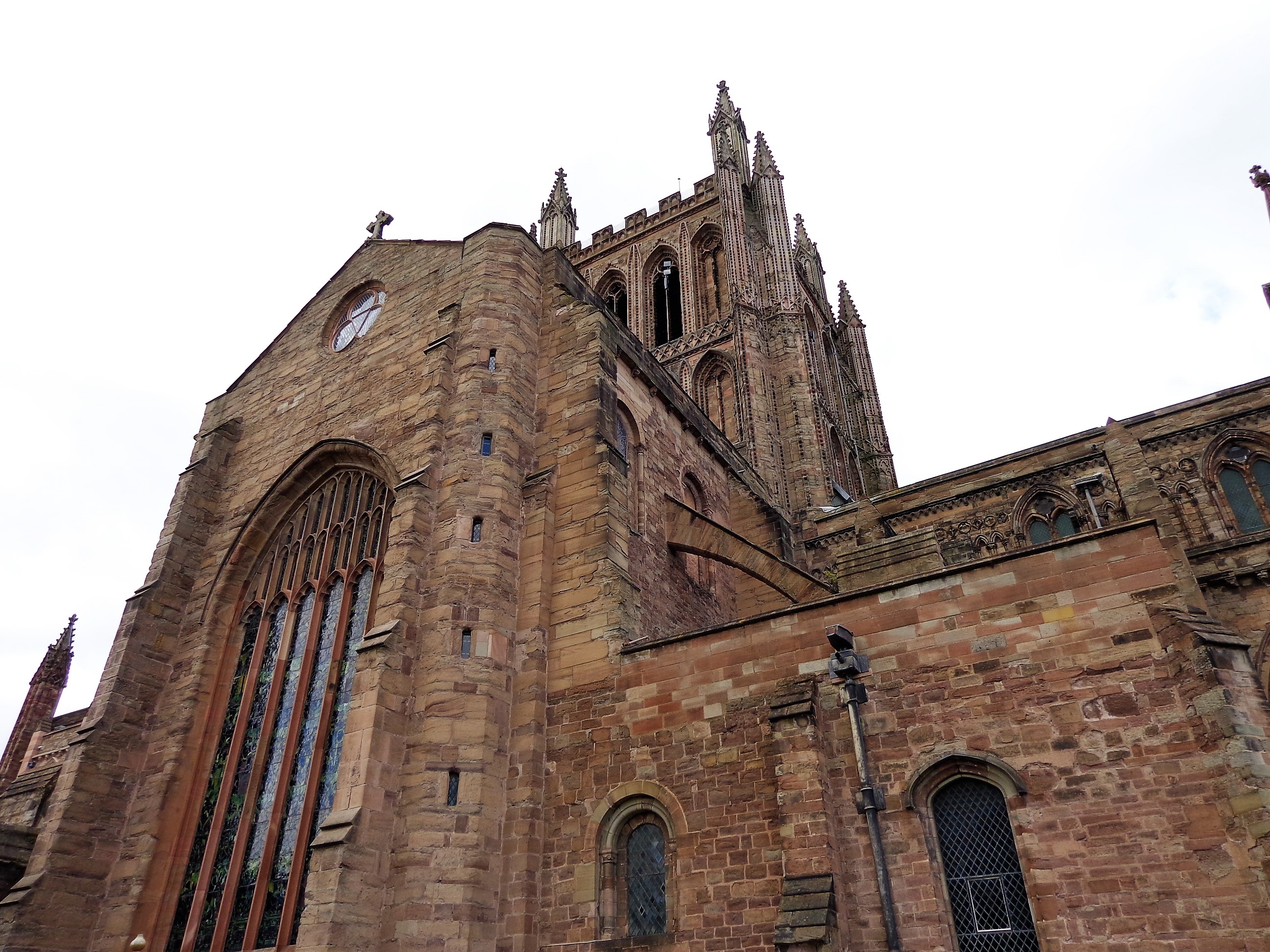 political
reasons, Offa had the young king executed on May 20,794. The body was
taken by oxcart to Hereford and on the journey his head fell from the
oxcart; it was rescued by a blind man, who received his sight.
political
reasons, Offa had the young king executed on May 20,794. The body was
taken by oxcart to Hereford and on the journey his head fell from the
oxcart; it was rescued by a blind man, who received his sight.
Ethelbert’s body was buried at Hereford and became the center of a
thriving pilgrimage cult. At Ethelbert's tomb miracles were said to have
occurred, and in the next century (about 830) Milfrid , a Mercian
nobleman, was so moved by the tales of these marvels that he rebuilt, in
stone, the little church which stood there, and was dedicated to the
sainted king. This cathedral stood for some 200 years, and then, in the
reign of Edward the Confessor, it was altered. The new church had only a
short life, for it was plundered and burnt in 1056 by a combined force
of Welsh and Irish.
 Hereford Cathedral remained in a state of ruin until Robert of
Lorraine was consecrated Bishop in 1079 and undertook its
reconstruction. His work was carried on by Bishop Reynelm, who was the
next one in the succession. Reynelm died in 1115, and it was only under
his third successor, Robert de Betun who was Bishop from 1131 to 1148,
that the church was completed.
Hereford Cathedral remained in a state of ruin until Robert of
Lorraine was consecrated Bishop in 1079 and undertook its
reconstruction. His work was carried on by Bishop Reynelm, who was the
next one in the succession. Reynelm died in 1115, and it was only under
his third successor, Robert de Betun who was Bishop from 1131 to 1148,
that the church was completed.
Of this Norman church, little has survived. Under Bishop Aquablanca
(1240–68), the rebuilding of the north transept was begun, being
completed later in the same century by Bishop Swinfield, who also built
the aisles of the nave and eastern transept.
In the first half of the 14th century the rebuilding of the
central tower was carried out. Around the middle of the 15th century a
tower was added to the western end of the nave. Between 1504 to 1535 the
last additions to the cathedral were made by erecting the north porch,
now forming the principal northern entrance. The building of the present
edifice therefore extended over a period of 440 years.
On Easter Monday1786, the greatest disaster in the history of the
cathedral took place. The west towe r fell, creating a ruin of the whole
of the west front and at least one part of the nave. The tower was in
the west bay of the nave. The tower was not rebuilt and the cathedral is
one bay shorter. The west front was restored over the period 1902 and
1908.
r fell, creating a ruin of the whole
of the west front and at least one part of the nave. The tower was in
the west bay of the nave. The tower was not rebuilt and the cathedral is
one bay shorter. The west front was restored over the period 1902 and
1908.
The West front doors have a very secure looking fence in front of them,
so it is necessary to enter the church on the north side.

The nave is
much shorter and not as tall as most of the cathedrals that we have
visited. The columns are around with several different designs on the
capitals which hold up the Romanesque rounded arches.

We walked down the central aisle, and approached the altar rail behind
which is a freestanding altar which is located in the crossing. The
choir is located between this altar and the high altar at the east end
of the cathedral.
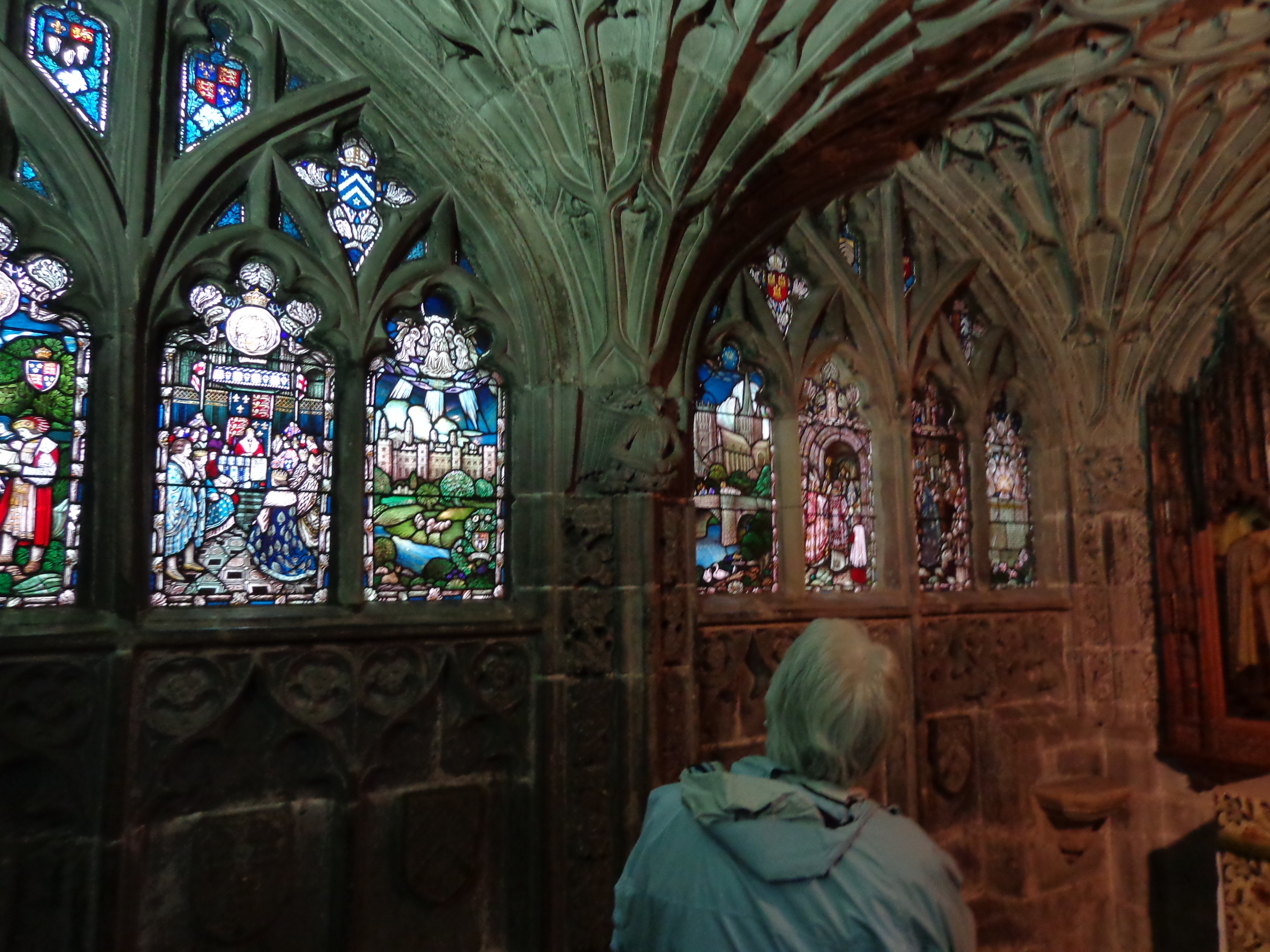 beautiful capital dedicated to Bishop John Stanbury, who was Bishop of
Hereford 1453–74. The windows in the chapel were designed by Arthur
Davies, show the life of Bishop Stanbury.
beautiful capital dedicated to Bishop John Stanbury, who was Bishop of
Hereford 1453–74. The windows in the chapel were designed by Arthur
Davies, show the life of Bishop Stanbury.
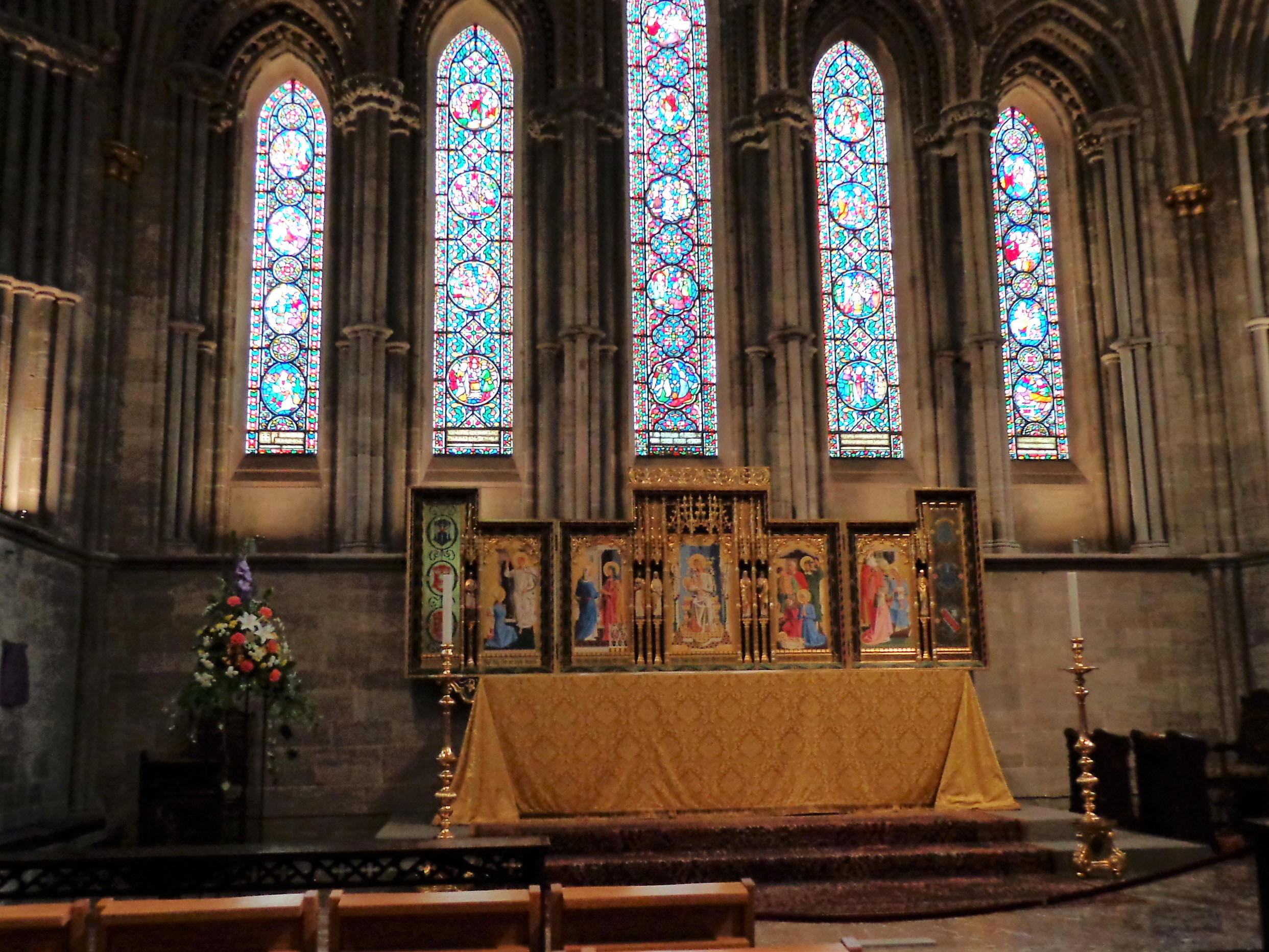
Behind the main altar, at the extreme east end is the Lady Chapel.
This chapel was built c.1220–30, with beautiful stained glass windows.
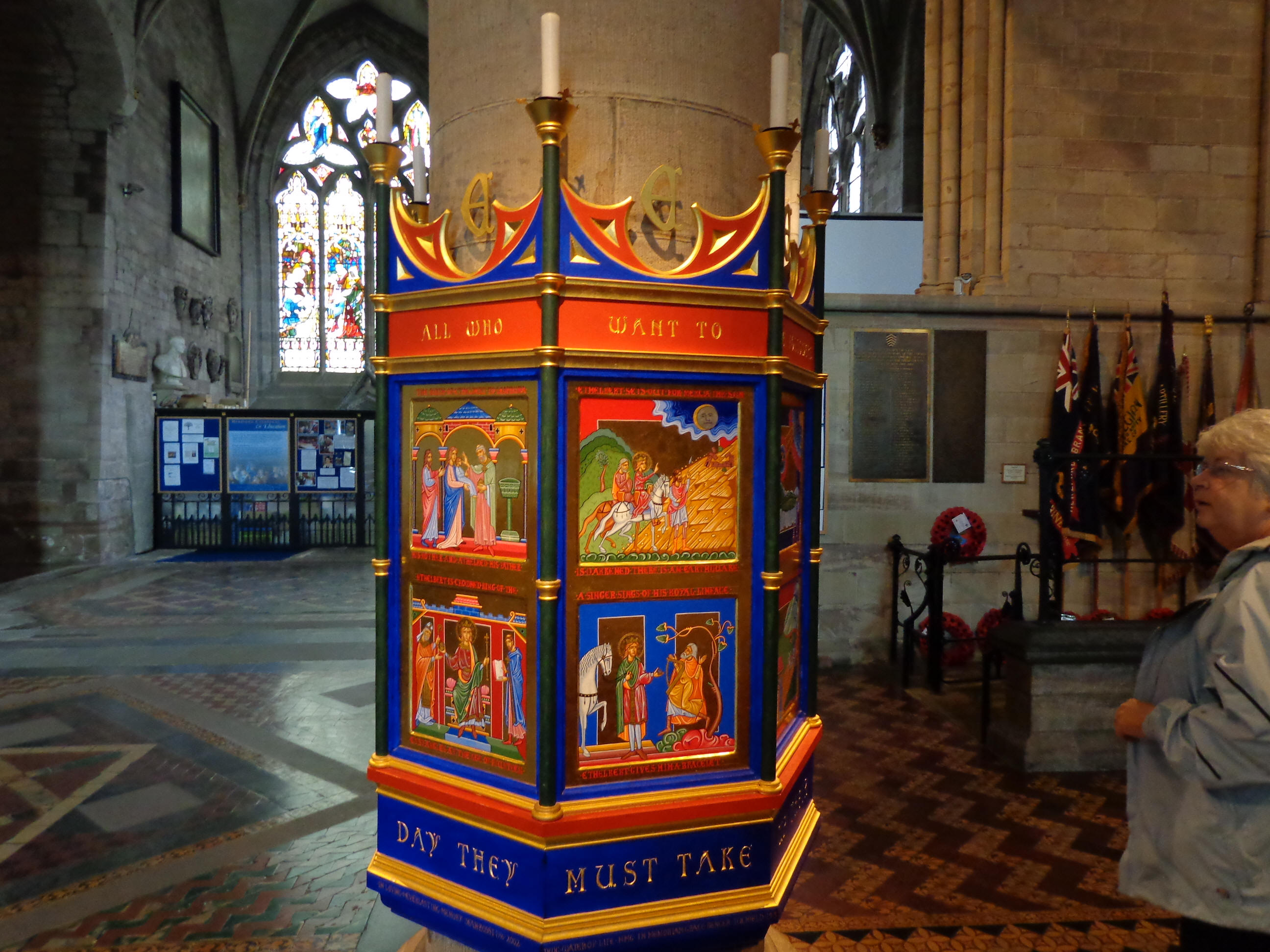
Near the front of the chapel stands a colorful remembrance of Ethelbert.
Ethelbert continues as the patron saint of Hereford Cathedral (a
patronage shared with the Virgin Mary).

On the right side of the Lady Chapel is a small chapel known as Audley
Chapel. This chapel contains four rather modern stained-glass windows
which commemorate the life of Thomas Traherne, who was born in Hereford
in 1636 the wind is, designed by Tom Danny were installed in 2007.
 On the left wall of the Lady Chapel is an the colorful tomb of Baron
Peter de Grandisson. Very little is known about this person.
On the left wall of the Lady Chapel is an the colorful tomb of Baron
Peter de Grandisson. Very little is known about this person.
We ate lunch in the tea room where they serve sandwiches called
Toasties. I had a cheese and pineapple and Kathleen had cheese and
tomato toasty. They were grilled and very good. We shared a raspberry
and coconut tart for dessert.
Then we went into part of the cloister that housed the famous Mappa
Mundi, which dates from the 13th century and is one of the world’s most
remarkable and important medieval works of art. It is a map which show
Jerusalem as the center of the world. No photography was allowed.
In the same area was a large room called the Library of Chains books,
which was an arrangement of very old book chained to the shelves.
People could read the books but they could not be removed. Some of the
books date back to the 8th century. We also saw one of the 4 copies of
the Magna Carta. Canon Pullin said that he is escorting this copy of
the Magna Carta to Houston to be exhibited in February.
Today, the BBC was recording Evensong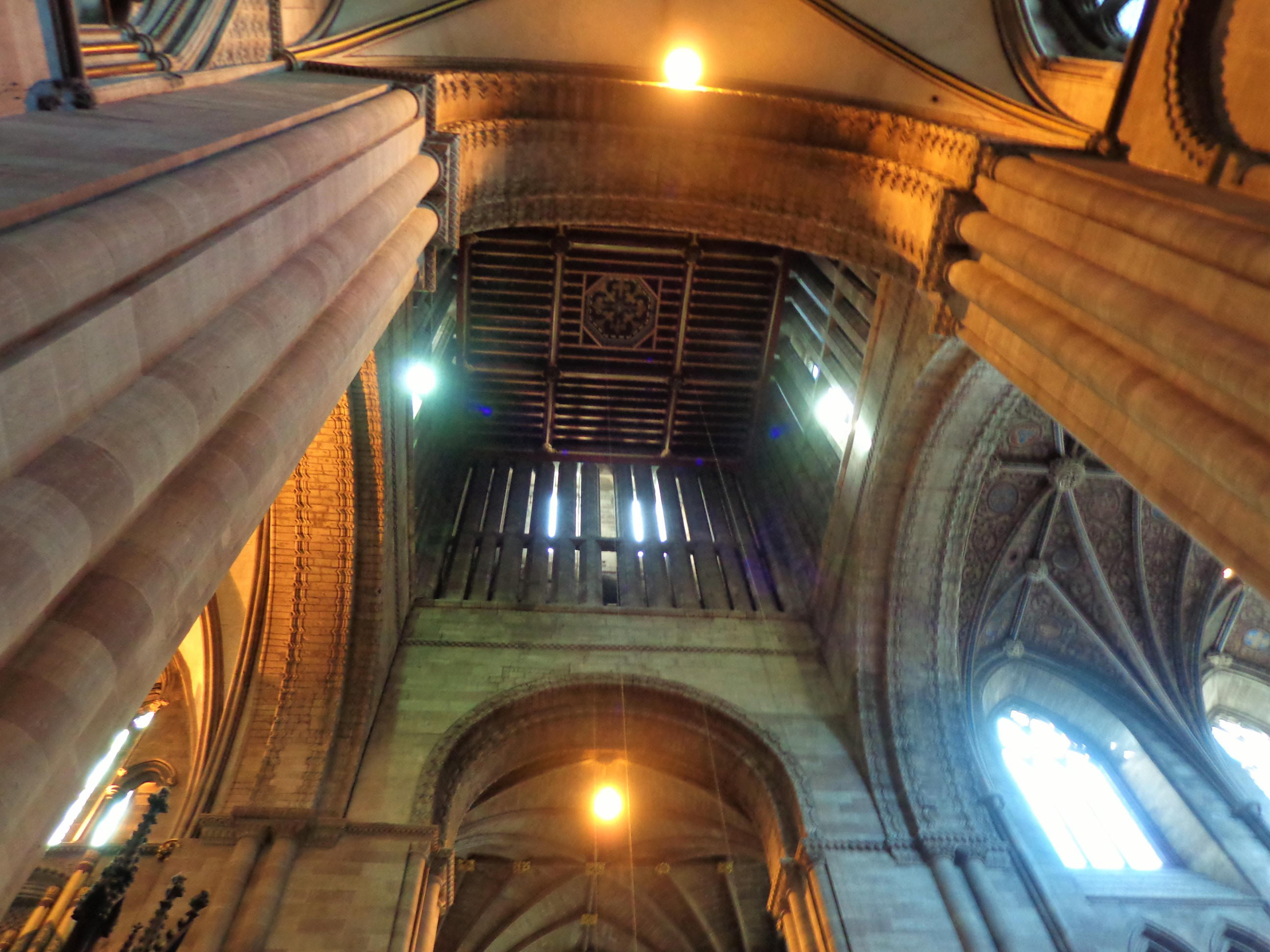 at 3:30, and we wanted to attend
the service. We realized we were running out of English pounds, so we
walk to a bank ATM next to the cathedral and got some cash so we could
pay our taxi fee.
at 3:30, and we wanted to attend
the service. We realized we were running out of English pounds, so we
walk to a bank ATM next to the cathedral and got some cash so we could
pay our taxi fee.
Then we went back for Evensong. The choir was men and boys. The boys
had on blue cassocks and long white cotta and a high ruffled collar.
The singing was wonderful as well as the organ which played a variation
on the music “New World Symphony”. At the c onclusion of the service
the man sitting next to me asked me if I was an Episcopalian. We
introduced ourselves. He was a Canon at Rippon Cathedral – which was
not on our list this year. His name was Brian Abell, and he has been
ordained 49 years. They were staying in Hereford so we walked up the
street with them until we found a taxi to take us back to the train
station. We had about a 30 minute wait for the train, so we went in
the coffee shop and had a cup of tea and a sweet.
onclusion of the service
the man sitting next to me asked me if I was an Episcopalian. We
introduced ourselves. He was a Canon at Rippon Cathedral – which was
not on our list this year. His name was Brian Abell, and he has been
ordained 49 years. They were staying in Hereford so we walked up the
street with them until we found a taxi to take us back to the train
station. We had about a 30 minute wait for the train, so we went in
the coffee shop and had a cup of tea and a sweet.
Back at our hotel, we decided to eat in the restaurant again. There are
no other places to eat close by and the food is very good and the
restaurant is attractive. We shared a rack of lamb, potato, and a
butternut squash puree. It was very good. We had a chocolate mousse
for dessert.
We catch another 10:00 train tomorrow for London. We will be in London
until Tuesday when we fly home.

 The train station was too far from the cathedral to walk, so took a
taxi. We went to the gift shop for our 11:00 tour. There was another
man who wanted to go on a tour, so we invited him to join us. Well, no
one showed up to give the tour and no one knew what happened to that
person. The cathedral staff were very embarrassed. After a bit, the
Chancellor, the Rev. Canon Chris Pullin, found us and spent some time
with us. They had called one of their guides, who was at the time
working in her garden. In about 15 minutes she showed up and gave us a
wonderful tour for about 2 ˝ hours.
The train station was too far from the cathedral to walk, so took a
taxi. We went to the gift shop for our 11:00 tour. There was another
man who wanted to go on a tour, so we invited him to join us. Well, no
one showed up to give the tour and no one knew what happened to that
person. The cathedral staff were very embarrassed. After a bit, the
Chancellor, the Rev. Canon Chris Pullin, found us and spent some time
with us. They had called one of their guides, who was at the time
working in her garden. In about 15 minutes she showed up and gave us a
wonderful tour for about 2 ˝ hours.  political
reasons, Offa had the young king executed on May 20,794. The body was
taken by oxcart to Hereford and on the journey his head fell from the
oxcart; it was rescued by a blind man, who received his sight.
political
reasons, Offa had the young king executed on May 20,794. The body was
taken by oxcart to Hereford and on the journey his head fell from the
oxcart; it was rescued by a blind man, who received his sight. Hereford Cathedral remained in a state of ruin until Robert of
Lorraine was consecrated Bishop in 1079 and undertook its
reconstruction. His work was carried on by Bishop Reynelm, who was the
next one in the succession. Reynelm died in 1115, and it was only under
his third successor, Robert de Betun who was Bishop from 1131 to 1148,
that the church was completed.
Hereford Cathedral remained in a state of ruin until Robert of
Lorraine was consecrated Bishop in 1079 and undertook its
reconstruction. His work was carried on by Bishop Reynelm, who was the
next one in the succession. Reynelm died in 1115, and it was only under
his third successor, Robert de Betun who was Bishop from 1131 to 1148,
that the church was completed.  r fell, creating a ruin of the whole
of the west front and at least one part of the nave. The tower was in
the west bay of the nave. The tower was not rebuilt and the cathedral is
one bay shorter. The west front was restored over the period 1902 and
1908.
r fell, creating a ruin of the whole
of the west front and at least one part of the nave. The tower was in
the west bay of the nave. The tower was not rebuilt and the cathedral is
one bay shorter. The west front was restored over the period 1902 and
1908. 
 beautiful capital dedicated to Bishop John Stanbury, who was Bishop of
Hereford 1453–74. The windows in the chapel were designed by Arthur
Davies, show the life of Bishop Stanbury.
beautiful capital dedicated to Bishop John Stanbury, who was Bishop of
Hereford 1453–74. The windows in the chapel were designed by Arthur
Davies, show the life of Bishop Stanbury.  On the left wall of the Lady Chapel is an the colorful tomb of Baron
Peter de Grandisson. Very little is known about this person.
On the left wall of the Lady Chapel is an the colorful tomb of Baron
Peter de Grandisson. Very little is known about this person.
